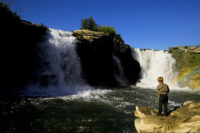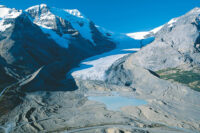Reptiles, amphibians at risk in Canada, says WWF study
By Kalinowski, Tim on February 12, 2020.
 A garter snake makes its way through colourful fall foliage in the city's river valley just outside the entrance walkway to the Helen Schuler Nature Centre. Herald file photo by Ian Martens @IMartensHerald
A garter snake makes its way through colourful fall foliage in the city's river valley just outside the entrance walkway to the Helen Schuler Nature Centre. Herald file photo by Ian Martens @IMartensHeraldTim Kalinowski
Lethbridge Herald
tkalinowski@lethbridgeherald.com
A recent study led by the Canadian chapter of the World Wildlife Federation found reptiles and amphibians are more at risk in Canada than any other classification of endangered or at-risk species.
“From logging to housing to industrial and agricultural development, the impact of humans continues to be felt by nature,” says WWF study lead Jessica Currie. “There’s still time to reverse the decline of wildlife, but we must be deliberate. As species are threatened by numerous compounding pressures, conservation action must address multiple threats at once.”
Curtis Goodman, resource development co-ordinator at the Helen Schuler Nature Centre, says he appreciates the WWF’s perspective and it’s something which should have a greater local awareness in Lethbridge.
“We definitely recognize that our amphibian and reptiles are indicator species, and we have to pay attention to the health of them,” he says. “Out of the 11 threat categories the WWF listed there are lot of those threats that are local pressures on our population here, and I would definitely agree as we expand our development of the city we are starting to see the loss of habitat. And some of that habitat is very valuable for our reptile and amphibian populations.”
Goodman admits the nature centre has no “hard data” on the state of the local amphibian and reptile populations, which include various snakes species, northern leopard frogs and prairie salamanders among others. But, anecdotally, he is hearing that development pressures have changed the habits of some local amphibian and reptile populations as they seek ways to adapt to the loss of habitat. He notes more rattlesnakes, for example, have been found in residential areas in recent years than in the past.
“As we have moved houses into snake territory, in tandem we have seen a big increase in the number of snake relocation calls,” he says. “I would expect that trend would continue.”
Local naturalist Ken Moore, whose primary interest is snakes, said it is surprising but he also is not aware of any recent snake population health studies being undertaken in Lethbridge since about 2006.
“Residential development, particularly in west Lethbridge, is of concern to people who appreciate snakes in particular because for thousands of years the snakes have gone up into the plains area to search for food,” he says. “And now with the residential development up there, they are curtailed in most areas from doing that.”
“I have always thought there should be a wildlife corridor down near the river between Cottonwood and Popson Park for some type of a pathway for not just rattlesnakes, but all types of wildlife. But I’m not sure if that’s even possible,” Moore admits.
Nor is he sure such a corridor would ultimately be meaningful without the City committing further resources to study the issue.
“Having wildlife corridors up top would certainly cut down on any type of residential construction, and I’m not sure if the City would be willing to go that way,” he says. “And I am not sure it would be that meaningful to the wildlife either. For the most part there is no residential development and no industrial development in the river bottom, and I think most of the wildlife is likely pretty healthy in the river valley.”
But again, Moore emphasizes, he has no hard data on the question either way.
To learn more about the local snake populations Moore will be holding a talk entitled “The 7 Snakes Found in Alberta” at the Helen Schuler Nature Centre this evening at 7 p.m.
Follow @TimKalHerald on Twitter
19-18




